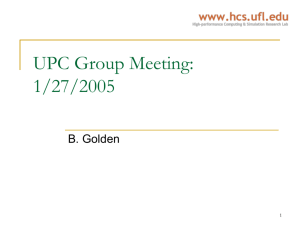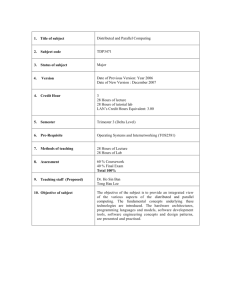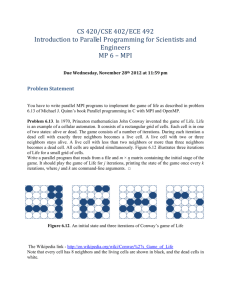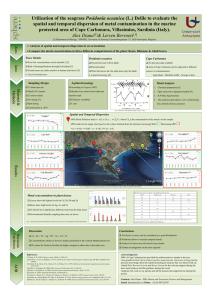William Gropp A R G
advertisement
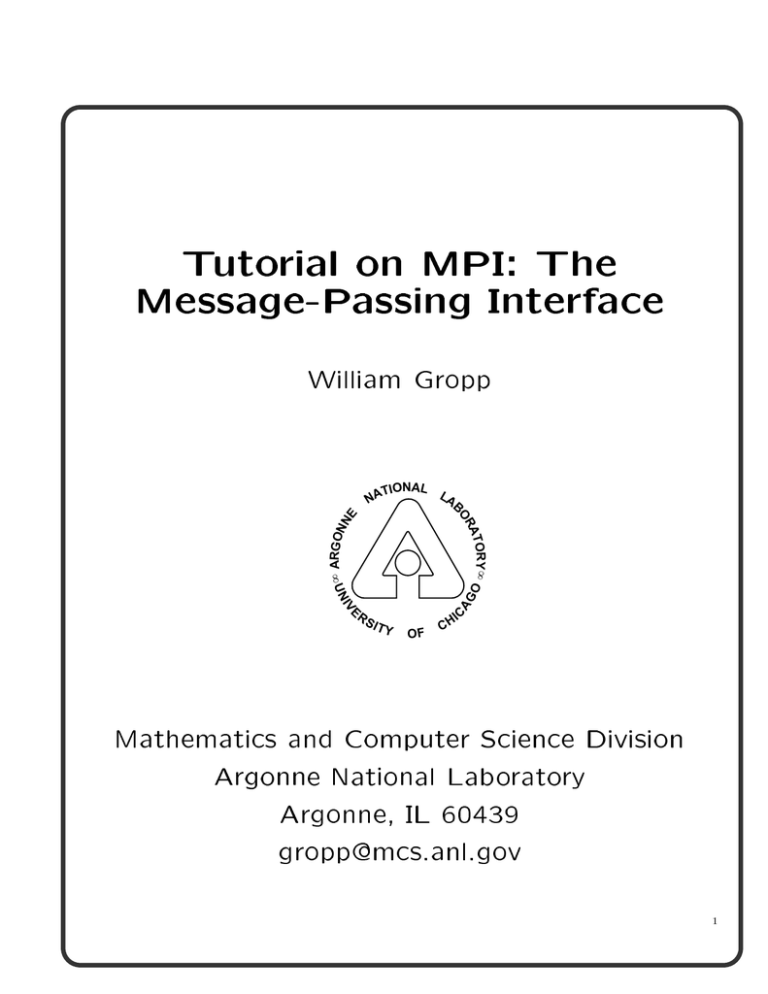
Tutorial on MPI: The
Message-Passing Interface
William Gropp
O•
AG
RS
I
C
V
NI
•U
E
RY
ATO
OR
ARGON
NE
TIONAL L
AB
NA
IT Y
OF
CH
Mathematics and Computer Science Division
Argonne National Laboratory
Argonne, IL 60439
gropp@mcs.anl.gov
1
Course Outline
Background on Parallel Computing
Getting Started
MPI Basics
Intermediate MPI
Tools for writing libraries
Final comments
Thanks to Rusty Lusk for some of the material in this
tutorial.
This tutorial may be used in conjunction with
the book \Using MPI" which contains detailed
descriptions of the use of the MPI routines.
Material that beings with this symbol is `advanced'
and may be skipped on a rst reading.
2
Background
Parallel Computing
Communicating with other processes
Cooperative operations
One-sided operations
The MPI process
3
Parallel Computing
Separate workers or processes
Interact by exchanging information
4
Types of parallel computing
All use dierent data for each worker
Data-parallel Same operations on dierent
data. Also called SIMD
SPMD Same program, dierent data
MIMD Dierent programs, dierent data
SPMD and MIMD are essentially the same
because any MIMD can be made SPMD
SIMD is also equivalent, but in a less
practical sense.
MPI is primarily for SPMD/MIMD. HPF is
an example of a SIMD interface.
5
Communicating with other processes
Data must be exchanged with other workers
Cooperative | all parties agree to
transfer data
One sided | one worker performs
transfer of data
6
Cooperative operations
Message-passing is an approach that makes
the exchange of data cooperative.
Data must both be explicitly sent and
received.
An advantage is that any change in the
receiver's memory is made with the receiver's
participation.
Process 0
Process 1
SEND( data )
RECV( data )
7
One-sided operations
One-sided operations between parallel
processes include remote memory reads and
writes.
An advantage is that data can be accessed
without waiting for another process
Process 0
Process 1
PUT( data )
(Memory)
Process 0
Process 1
(Memory)
GET( data )
8
Class Example
Take a pad of paper. Algorithm: Initialize with the
number of neighbors you have
Compute average of your neighbor's values and
subtract from your value. Make that your new
value.
Repeat until done
Questions
1. How do you get values from your neighbors?
2. Which step or iteration do they correspond to?
Do you know? Do you care?
3. How do you decide when you are done?
9
Hardware models
The previous example illustrates the
hardware models by how data is exchanged
among workers.
Distributed memory (e.g., Paragon, IBM
SPx, workstation network)
Shared memory (e.g., SGI Power
Challenge, Cray T3D)
Either may be used with SIMD or MIMD
software models.
All memory is distributed.
10
What is MPI?
A message-passing library specication
{ message-passing model
{ not a compiler specication
{ not a specic product
For parallel computers, clusters, and heterogeneous
networks
Full-featured
Designed to permit (unleash?) the development of
parallel software libraries
Designed to provide access to advanced parallel
hardware for
{ end users
{ library writers
{ tool developers
11
Motivation for a New Design
Message Passing now mature as programming
paradigm
{ well understood
{ ecient match to hardware
{ many applications
Vendor systems not portable
Portable systems are mostly research projects
{ incomplete
{ lack vendor support
{ not at most ecient level
12
Motivation (cont.)
Few systems oer the full range of desired features.
modularity (for libraries)
access to peak performance
portability
heterogeneity
subgroups
topologies
performance measurement tools
13
The MPI Process
Began at Williamsburg Workshop in April, 1992
Organized at Supercomputing '92 (November)
Followed HPF format and process
Met every six weeks for two days
Extensive, open email discussions
Drafts, readings, votes
Pre-nal draft distributed at Supercomputing '93
Two-month public comment period
Final version of draft in May, 1994
Widely available now on the Web, ftp sites, netlib
(http://www.mcs.anl.gov/mpi/index.html)
Public implementations available
Vendor implementations coming soon
14
Who Designed MPI?
Broad participation
Vendors
{ IBM, Intel, TMC, Meiko, Cray, Convex, Ncube
Library writers
{ PVM, p4, Zipcode, TCGMSG, Chameleon,
Express, Linda
Application specialists and consultants
Companies
ARCO
Convex
Cray Res
IBM
Intel
KAI
Meiko
NAG
nCUBE
ParaSoft
Shell
TMC
Laboratories
ANL
GMD
LANL
LLNL
NOAA
NSF
ORNL
PNL
Sandia
SDSC
SRC
Universities
UC Santa Barbara
Syracuse U
Michigan State U
Oregon Grad Inst
U of New Mexico
Miss. State U.
U of Southampton
U of Colorado
Yale U
U of Tennessee
U of Maryland
Western Mich U
U of Edinburgh
Cornell U.
Rice U.
U of San Francisco
15
Features of MPI
General
{ Communicators combine context and group for
message security
{ Thread safety
Point-to-point communication
{ Structured buers and derived datatypes,
heterogeneity
{ Modes: normal (blocking and non-blocking),
synchronous, ready (to allow access to fast
protocols), buered
Collective
{ Both built-in and user-dened collective
operations
{ Large number of data movement routines
{ Subgroups dened directly or by topology
16
Features of MPI (cont.)
Application-oriented process topologies
{ Built-in support for grids and graphs (uses
groups)
Proling
{ Hooks allow users to intercept MPI calls to
install their own tools
Environmental
{ inquiry
{ error control
17
Features not in MPI
Non-message-passing concepts not included:
{ process management
{ remote memory transfers
{ active messages
{ threads
{ virtual shared memory
MPI does not address these issues, but has tried to
remain compatible with these ideas (e.g. thread
safety as a goal, intercommunicators)
18
Is MPI Large or Small?
MPI is large (125 functions)
{ MPI's extensive functionality requires many
functions
{ Number of functions not necessarily a measure
of complexity
MPI is small (6 functions)
{ Many parallel programs can be written with just
6 basic functions.
MPI is just right
{ One can access exibility when it is required.
{ One need not master all parts of MPI to use it.
19
Where to use MPI?
You need a portable parallel program
You are writing a parallel library
You have irregular or dynamic data
relationships that do not t a data
parallel model
Where not to use MPI:
You can use HPF or a parallel Fortran 90
You don't need parallelism at all
You can use libraries (which may be
written in MPI)
20
Why learn MPI?
Portable
Expressive
Good way to learn about subtle issues in
parallel computing
21
Getting started
Writing MPI programs
Compiling and linking
Running MPI programs
More information
{ Using MPI by William Gropp, Ewing Lusk,
and Anthony Skjellum,
{ The LAM companion to \Using MPI..." by
Zdzislaw Meglicki
{ Designing and Building Parallel Programs by
Ian Foster.
{ A Tutorial/User's Guide for MPI by Peter
Pacheco
(ftp://math.usfca.edu/pub/MPI/mpi.guide.ps)
{ The MPI standard and other information is
available at http://www.mcs.anl.gov/mpi. Also
the source for several implementations.
22
Writing MPI programs
#include "mpi.h"
#include <stdio.h>
int main( argc, argv )
int argc;
char **argv;
{
MPI_Init( &argc, &argv );
printf( "Hello world\n" );
MPI_Finalize();
return 0;
}
23
Commentary
provides basic MPI
denitions and types
MPI_Init starts MPI
MPI_Finalize exits MPI
Note that all non-MPI routines are local;
thus the printf run on each process
#include "mpi.h"
24
Compiling and linking
For simple programs, special compiler
commands can be used. For large projects,
it is best to use a standard Makele.
The MPICH implementation provides
the commands mpicc and mpif77
as well as `Makefile' examples in
`/usr/local/mpi/examples/Makefile.in'
25
Special compilation commands
The commands
mpicc -o first first.c
mpif77 -o firstf firstf.f
may be used to build simple programs when using
MPICH.
These provide special options that exploit the proling
features of MPI
-mpilog Generate log les of MPI calls
-mpitrace Trace execution of MPI calls
-mpianim Real-time animation of MPI (not available
on all systems)
There are specic to the MPICH implementation;
other implementations may provide similar commands
(e.g., mpcc and mpxlf on IBM SP2).
26
Using Makeles
The le `Makefile.in' is a template Makele.
The program (script) `mpireconfig' translates
this to a Makele for a particular system.
This allows you to use the same Makele for
a network of workstations and a massively
parallel computer, even when they use
dierent compilers, libraries, and linker
options.
mpireconfig Makefile
Note that you must have `mpireconfig' in
your PATH.
27
Sample Makele.in
##### User configurable options #####
ARCH
= @ARCH@
COMM
= @COMM@
INSTALL_DIR = @INSTALL_DIR@
CC
= @CC@
F77
= @F77@
CLINKER
= @CLINKER@
FLINKER
= @FLINKER@
OPTFLAGS
= @OPTFLAGS@
#
LIB_PATH
= -L$(INSTALL_DIR)/lib/$(ARCH)/$(COMM)
FLIB_PATH
=
@FLIB_PATH_LEADER@$(INSTALL_DIR)/lib/$(ARCH)/$(COMM)
LIB_LIST
= @LIB_LIST@
#
INCLUDE_DIR = @INCLUDE_PATH@ -I$(INSTALL_DIR)/include
### End User configurable options ###
28
Sample Makele.in (con't)
CFLAGS = @CFLAGS@ $(OPTFLAGS) $(INCLUDE_DIR) -DMPI_$(ARCH)
FFLAGS = @FFLAGS@ $(INCLUDE_DIR) $(OPTFLAGS)
LIBS = $(LIB_PATH) $(LIB_LIST)
FLIBS = $(FLIB_PATH) $(LIB_LIST)
EXECS = hello
default: hello
all: $(EXECS)
hello: hello.o $(INSTALL_DIR)/include/mpi.h
$(CLINKER) $(OPTFLAGS) -o hello hello.o \
$(LIB_PATH) $(LIB_LIST) -lm
clean:
/bin/rm -f *.o *~ PI* $(EXECS)
.c.o:
$(CC) $(CFLAGS) -c $*.c
.f.o:
$(F77) $(FFLAGS) -c $*.f
29
Running MPI programs
mpirun -np 2 hello
`mpirun' is not part of the standard, but
some version of it is common with several
MPI implementations. The version shown
here is for the MPICH implementation of
MPI.
Just as Fortran does not specify how
Fortran programs are started, MPI does not
specify how MPI programs are started.
The option -t shows the commands that
mpirun would execute; you can use this to
nd out how mpirun starts programs on yor
system. The option -help shows all options
to mpirun.
30
Finding out about the environment
Two of the rst questions asked in a parallel
program are: How many processes are there?
and Who am I?
How many is answered with MPI_Comm_size
and who am I is answered with MPI_Comm_rank.
The rank is a number between zero and
size-1.
31
A simple program
#include "mpi.h"
#include <stdio.h>
int main( argc, argv )
int argc;
char **argv;
{
int rank, size;
MPI_Init( &argc, &argv );
MPI_Comm_rank( MPI_COMM_WORLD, &rank );
MPI_Comm_size( MPI_COMM_WORLD, &size );
printf( "Hello world! I'm %d of %d\n",
rank, size );
MPI_Finalize();
return 0;
}
32
Caveats
These sample programs have been kept
as simple as possible by assuming that all
processes can do output. Not all parallel
systems provide this feature, and MPI
provides a way to handle this case.
33
Exercise - Getting Started
Objective: Learn how to login, write,
compile, and run a simple MPI program.
Run the \Hello world" programs. Try two
dierent parallel computers. What does the
output look like?
34
Sending and Receiving messages
Process 0
Process 1
A:
Send
Recv
B:
Questions:
To whom is data sent?
What is sent?
How does the receiver identify it?
35
Current Message-Passing
A typical blocking send looks like
send( dest, type, address, length )
where
{ dest is an integer identier representing the
process to receive the message.
{ type is a nonnegative integer that the
destination can use to selectively screen
messages.
{ (address, length) describes a contiguous area in
memory containing the message to be sent.
and
A typical global operation looks like:
broadcast( type, address, length )
All of these specications are a good match to
hardware, easy to understand, but too inexible.
36
The Buer
Sending and receiving only a contiguous array of
bytes:
hides the real data structure from hardware which
might be able to handle it directly
requires pre-packing dispersed data
{ rows of a matrix stored columnwise
{ general collections of structures
prevents communications between machines with
dierent representations (even lengths) for same
data type
37
Generalizing the Buer Description
Specied in MPI by starting address, datatype, and
count, where datatype is:
{ elementary (all C and Fortran datatypes)
{ contiguous array of datatypes
{ strided blocks of datatypes
{ indexed array of blocks of datatypes
{ general structure
Datatypes are constructed recursively.
Specications of elementary datatypes allows
heterogeneous communication.
Elimination of length in favor of count is clearer.
Specifying application-oriented layout of data
allows maximal use of special hardware.
38
Generalizing the Type
A single type eld is too constraining. Often
overloaded to provide needed exibility.
Problems:
{ under user control
{ wild cards allowed (MPI_ANY_TAG)
{ library use conicts with user and with other
libraries
39
Sample Program using Library Calls
Sub1
and Sub2 are from dierent libraries.
Sub1();
Sub2();
Sub1a
and Sub1b are from the same library
Sub1a();
Sub2();
Sub1b();
Thanks to Marc Snir for the following four examples
40

